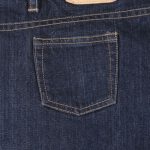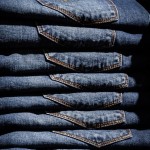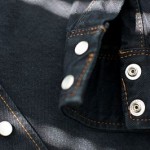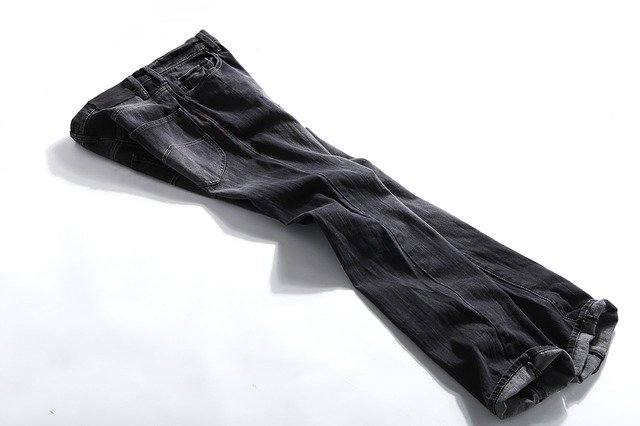
by MakeYourOwnJeans | jeans |
Want to dry your jeans without using heat? Heat typically makes jeans, as well as other garments, dry more quickly. When exposed to heat, the water within a pair of recently washed jeans will evaporate, thereby drying them. There are instances, however, in which you may want to dry your jeans without using heat. Stretch jeans, for instance, are more vulnerable to shrinkage when exposed to heat than their non-stretch counterparts. They contain a small amount of an elastic material, such as polyester or lycra. If exposed to heat, this elastic material will shrink, which may cause the stretch jeans to no longer fit. Whether your jeans are made of regular denim or stretch denim, you can dry them without using heat in one of several ways. Use the ‘Fluff’ Setting You can safely dry your jeans without using heat by turning your dryer to the “fluff” setting. The “fluff” setting isn’t necessarily designed to fluff your clothes. Rather, it’s designed to dry clothes without heat. Most modern dryers have a “fluff” setting.” It works in the same as the other settings but without heat. Your jeans will tumble around inside of the dryer’s cylinder drum, thus drying them. Keep in mind that without heat, it will take jeans a little longer to dry. Depending on the type of dryer you have, as well as the type of jeans, it may take about 30 minutes. Nonetheless, the “fluff” setting offers a safe and effective way to dry your jeans without exposing them to heat. Use a Hairdryer Another way to dry your eans without using heat is to run...
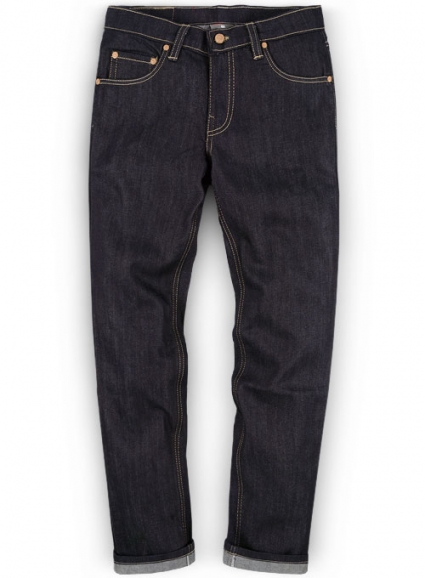
by MakeYourOwnJeans | jeans |
Jeans are typically made of either raw or washed denim. Both materials consist of the same cotton-based material with a warp-faced weaving pattern. The difference is that raw denim isn’t washed or otherwise treated during production. While there are plenty of amazing jeans available in both raw denim and washed denim, the former type several benefits. To learn more about raw denim jeans and why you should choose them, keep reading. #1) Darker Tone Raw denim jeans typically feature a darker tone than their washed counterparts. Washed denim is characterized by a bathing process where it’s submerged in water and, in some cases, treated with various chemicals. This process strips away some of the denim’s dye, resulting in a lighter tone. You can still find washed denim jeans in dark colors, such as black and indigo. When compared to raw denim jeans, though, they usually have a lighter tone. If you’re searching for a pair of jeans with a dark tone, there’s no better choice than raw denim. Raw denim jeans have an extra-dark tone that’s not found in their washed counterparts. To preserve the naturally dark tone of raw denim jeans, consider the following tips: Store them away from direct sunlight.Wash in cold water.Dry using low or no heat.Rather than using a dryer, consider line-drying them.Wash less frequently.Read and follow the instructions on the care tag.Spot clean using water and laundry detergent.Choose jeans made of premium and high-quality raw denim. #2) Natural Fading Whether your jeans are made of washed denim or raw denim, they’ll fade over time. Fading is something that occurs naturally with all colored garments....

by MakeYourOwnJeans | jeans |
Are you looking to buy new jeans for the winter? While you can wear jeans year-round, some of them are better suited for the cold winter weather than others. You can’t expect to stay warm if you wear thin jeans with little or no insulation. They may look amazing, but they won’t protect you from the cold weather. Fortunately, there are plenty of high-quality jeans available that are perfect for the winter. Here are some tips on how to choose the perfect jeans for the winter. Pure Denim Jeans made of pure denim are typically better suited for the cold winter weather than those made of other materials. Pure denim means they are made entirely of denim. Some people assume that all jeans are made of pure denim, but this isn’t necessarily true. While most jeans are, in fact, made of pure denim, others are made of multiple materials. Stretch jeans, for instance, are made of denim and an elastic material. They contain a small amount of an elastic material, such as polyester or lycra, which increases their elasticity. There’s nothing wrong with stretch jeans, but if you’re looking for a pair of warm jeans to wear during the winter, you may want to look elsewhere. Jeans made of pure denim tend to offer a higher level of protection against the cold winter weather, making them preferable for this time of year. Heavyweight Construction In addition to pure denim, consider choosing a pair of jeans featuring a heavyweight construction. Different jeans are made of different amounts of denim. Even if two pairs of jeans are made of pure denim,...
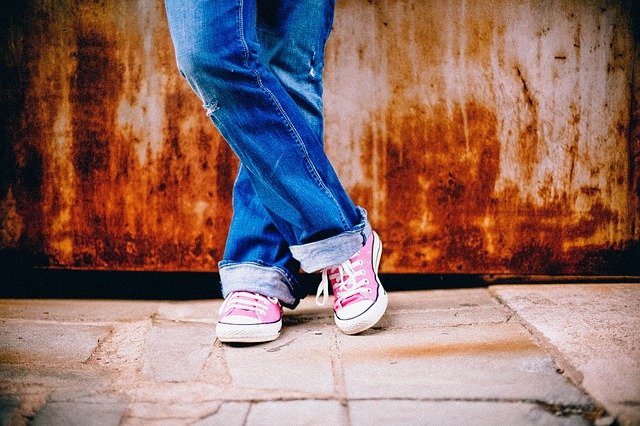
by MakeYourOwnJeans | jeans |
Jeans come in many different styles. While some of them have narrow and straight legs, others have wide legs. Known as wide-leg jeans, they’ve become a popular choice among fashion-conscious women. Wide-leg jeans are comfortable, stylish and long-lasting. Unless you’ve worn them in the past, though, you might be wondering how wide-leg jeans differ from other denim styles. An Introduction to Wide-Leg Jeans Wide-leg jeans are denim trousers that are designed to fit loosely in the legs. They don’t run straight through the legs, nor do they become narrower through the legs. Wide-leg jeans have a tapered design in which they become baggier towards the bottom. Although there’s no universal definition for the term, jeans are typically considered wide-leg if they measure at least 20 inches in the hem. To find this measurement, take a tape measure and run it across the bottom-most part of one of the pant legs. If it’s 20 inches or wider, they are probably wide-leg jeans. Wide-leg jeans are usually labeled as well. If a pair of jeans is designed with tapered legs that become wider towards the bottom, they will likely feature “wide-leg” on the tag. Some people assume that wide-leg jeans are a new fashion trend, but this isn’t necessarily true. Although they’ve risen in popularity as of late, wide-leg jeans have actually been around for several decades. Some of the first wide-leg jeans appeared during the 1980s, during which they were worn by famous musicians and celebrities. Over the next two decades, the general public took notice by wearing them as well. Today, wide-leg jeans Reasons to Choose Wide-Leg Jeans Wide-leg...
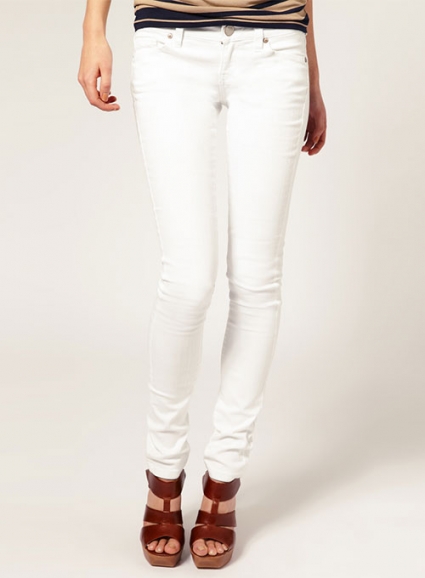
by MakeYourOwnJeans | jeans |
Blue isn’t the only color in which jeans are made. You can find jeans in white as well. White jeans are still made of denim, the only difference is that they are dyed white rather than blue. With that said, choosing white jeans offers several benefits, some of which may surprise you. #1) Less Fading White jeans are less susceptible to fading than blue and other dark-colored jeans. Fading occurs when the dye is released out of a garment’s fabric. All jeans contain dye. If the dye is released, the garment will fade to a lighter tone. Fortunately, white jeans offer a high level of protection against fading. They still contain dye, but they don’t suffer from the same degree of fading as other jeans. Jeans are made of denim. Denim, of course, is a type of cotton fabric. Since cotton is naturally white, white jeans typically don’t fade as much as other jeans. #2) Mix Up Your Outfits Choosing white jeans will allow you to mix up your outfits. If you only own blue jeans, you may struggle to wear certain outfits. Not all colors match blue. While blue is a relatively universal color, some colors — such as brown — clash with it. You can still buy and wear jeans in other colors, but don’t overlook the benefits of white jeans. With white jeans, you can mix up your outfits. White compliments all other colors. There are no colors on the color wheel that clash with white. Therefore, you can wear white jeans with all of your outfits. Only wearing blue jeans is a mistake. There’s nothing...

by MakeYourOwnJeans | jeans |
Ever wonder why some jeans are softer than others? Some of them may a fluffy and supple texture, whereas others have a stiff and rigid texture. Being that all jeans are made of the same material — denim — conventional wisdom may lead you to believe that they should feel the same. But this isn’t the case. Some jeans are softer than others. In this post, we’re going to investigate why some jeans are softer than others. Washed Denim Jeans made of washed denim are typically softer than those made of dry denim. Washed denim jeans are distinguished from dry denim jeans by the way in which they are produced. They are produced using denim that’s submerged in water. In comparison, dry denim jeans are made of dry denim that isn’t washed or otherwise submerged in water. It’s important to note that there are two types of washed denim jeans: Soft washed: The denim is submerged in cold water.Hard washed: The denim is submerged in hot water. Since they are made of pre-soaked denim, washed denim jeans tend to be softer than their dry denim counterparts. Submerging denim in water helps to soften it. When exposed to water, denim becomes softer and suppler. Hard washed jeans are the softest, but even cold washed jeans are noticeably softer than dry denim jeans. Whether hot or cold, water will soften jeans. Quality of Denim Some jeans are soft simply because they are made of high-quality denim. You have to remember that denim is comprised of cotton. Many people assume that denim is a synthetic material that’s manufactured in a factory. While...








